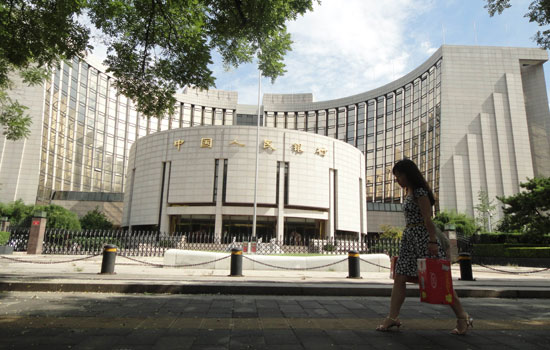

A dramatic change is taking place in China's liquidity supply situation as capital flows out of the world's second-largest economy amid calls for monetary authorities to look for new ways to inject money into the economy, said analysts.
|
 |
|
The People's Bank of China headquarters in Beijing. Experts say the central bank needs to find new ways to issue currency if it wants to maintain a stable increase in the money supply. [Photo/China Daily] |
"For a long time, Chinese banks' yuan holdings for purchasing foreign exchange have been a channel for the central bank to create money. Now the old pattern is about to change, which means the central bank needs to find new ways to issue currency if it wants to maintain stable money supply growth," said Cao Yuanzheng, chief economist at the Bank of China Ltd.
China posted a monthly capital outflow in August for the third time in 2012, as its economic growth fell to a three-year low and softened for the sixth consecutive quarter.
Yuan holdings among banks for purchasing foreign exchange, an important measure of capital flows, declined by 17.4 billion yuan ($2.75 billion) in August to 25.64 trillion yuan, marking the second straight monthly fall.
It widened from a decline of 3.8 billion yuan in July as the nation's economic growth slowed to its lowest rate in three years.
Foreign exchange has become a main source of the country's liquidity over the past two decades as the central bank sterilized its fluctuation to stabilize the yuan exchange rate.
Yuan holdings of foreign exchange purchases started to increase at the beginning of the year after three consecutive monthly declines in the fourth quarter of 2011. But the hikes ended in April, when a 60.6 billion yuan monthly fall was reported.
In the first eight months, the average monthly increase of yuan holdings was only 35.2 billion yuan, far from the average monthly gain of 231.6 billion throughout last year.
"In August, despite the significant drop in international market hedging demand, banks' yuan holdings still declined. This proves that pressure for yuan devaluation will remain in the medium and long term," said Liu Yuhui, director of the financial lab of the Chinese Academy of Social Sciences.
This year, offshore non-deliverable yuan forwards have been higher than the onshore spot exchange rate, and the spread between the two is likely to become much greater, "which indicates that expectations remain that the yuan will depreciate", said Cao.
"But we tend to believe that the conditions do not exist for the yuan to depreciate further, as the Chinese economy is still in a stable and controllable range, and foreign reserves remain large."
The depreciation tendency once again indicates that the yuan's exchange rate is close to equilibrium, he said.
"We believe that capital flows related to yuan exchange rate expectations is the most uncertain factor affecting overall capital flows," said Wang Tao, head of China economic research at UBS Securities Co Ltd.
Capital outflows will be constant and substantial as China's current account surplus continues to decline and global demand remains weak. The trend is also due to growing expectations that the yuan will depreciate, and the fact that Chinese residents prefer to hold foreign assets, she said.
"The financial account deficit plus a lower current account surplus means that China may have entered a new era, that is, the stagnant growth of foreign exchange reserves."
 Huawei launches new smartphone P9 in Vietnam
Huawei launches new smartphone P9 in Vietnam
 Top 10 box office movies on China market in H1
Top 10 box office movies on China market in H1
 Woman resigned from high salary job to make notebooks
Woman resigned from high salary job to make notebooks
 Hurun publishes Global Chinese Big Philanthropy Report 2016
Hurun publishes Global Chinese Big Philanthropy Report 2016
 Top 10 new economy issues in China
Top 10 new economy issues in China
 Wetland helps preserve ecology of Dianchi Lake
Wetland helps preserve ecology of Dianchi Lake
 A million ways to beat the summer heat
A million ways to beat the summer heat
 Top 10 livable Chinese cities
Top 10 livable Chinese cities

